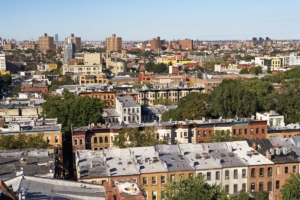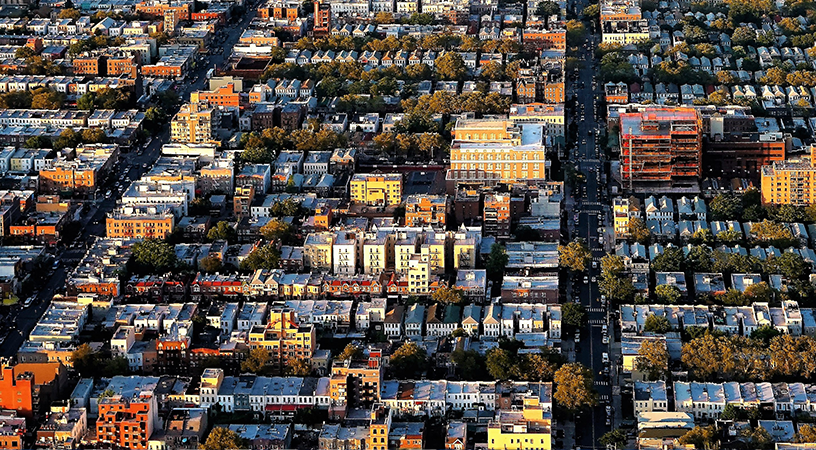
A new StreetEasy analysis quantifies the struggle to find an affordable apartment in NYC.
Key Findings:
- StreetEasy’s 2019 Rent Affordability Report quantifies the struggle to find an affordable apartment in NYC.
- Renters on a smaller budget tend to search over a much larger area to find a home, and often have to sacrifice their preferred location and price point in the end. Higher-budget renters tend to choose where they want to live, then consider apartments over a wide range of prices within it.
- For units around $1,800 per month, New Yorkers search over an average area of 4.9 square miles, while for units around $4,000 per month, the average apartment search spans just 1.4 square miles.
- For many shoppers, price and value seem to converge around $2,700: Renters looking at homes below that level are likely to look at more expensive units over time, while those who start searching above $2,700 will come down in price as they look.
- In general, renters on tighter budgets tend to look at higher-priced units over time, while those who start looking at more expensive homes tend to look at cheaper ones as they hunt.
~
Every New Yorker knows that finding an affordable home here means weighing endless trade-offs: Would you rather have a 15-minute walk to the subway, or a fifth-floor walk-up? Live closer to work, or closer to a playground for your kids?
A new look at StreetEasy users’ anonymized rental search data shows there may actually be one price point where these trade-offs start to balance out — where, for many NYC shoppers, price and value seem to converge.
That price point is about $2,700 per month. That’s nearly double what would be considered affordable on NYC’s annual median income of $57,782 per year [1], assuming the usual 40 times the monthly rent rule.
When NYC apartment hunters start looking at homes below $2,700, they tend to look at more expensive ones over the course of their search. When they begin searching above this price point, they tend to look at less expensive units.
We uncovered this figure as part of a detailed new analysis of the trade-offs New Yorkers make when searching for homes. Sifting through the millions of times StreetEasy renters saved listings during 2018, we were able to quantify New Yorkers’ struggle to find an affordable apartment.
We found some commonalities: It turns out that most renters, regardless of their budget, tend to save roughly 10 or 11 homes over the course of their search. But while all New Yorkers make trade-offs when selecting a home, those trade-offs vary dramatically with the size of searchers’ budgets.
Illustration: A Tale of Two Apartment Searches
Take the cases of two hypothetical renters we’ll call Rachel and Rebecca. Rachel wants to live in Brooklyn, has a budget of $1,800, and expresses interest in homes in a few different neighborhoods. Rebecca has a higher budget — around $4,000 — and knows she wants to live in a convenient section of Downtown Manhattan.
>>Scroll through the map below to see how Rachel and Rebecca’s searches differ.
When we chart how these searches vary, we can see that as New Yorkers hunt for a desirable apartment within their budget, they make trade-offs that follow five major patterns:
1. Renters on tighter budgets show much less flexibility in price than those seeking more expensive homes.
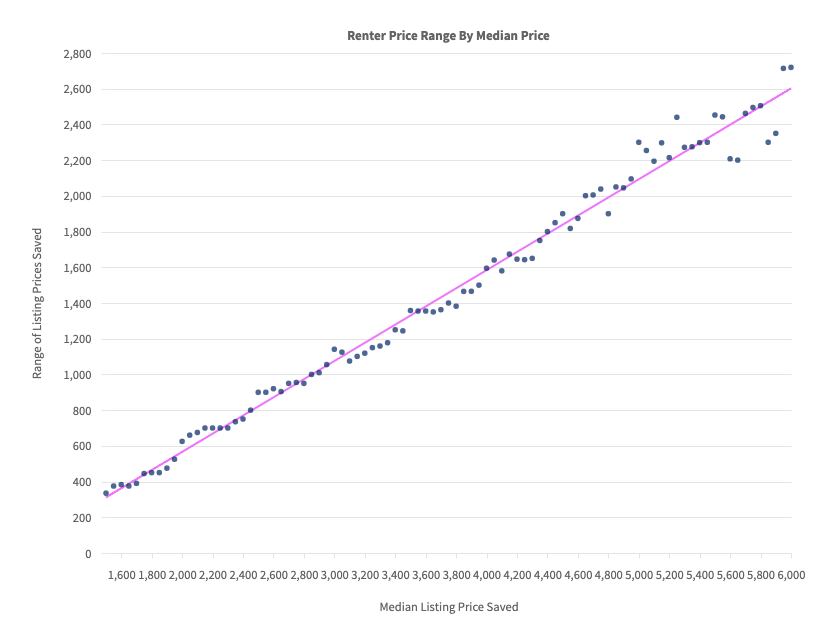
It might seem obvious that a $50 increase in rent means much more to someone shopping for an apartment at $2,000 than to someone searching at $4,000. But we see that those searching at the higher end consider a price range much wider than an equivalent share of their budget.
For renters searching for apartments around $2,000, the average difference between their most expensive and least expensive saved listings was $660, or 33 percent of the median listing they saved. So on average, renters searching for homes around $2,000 will save listings priced between $1,670 and $2,330.
Yet for renters seeking units around $4,000, the average range was $1,646 — more than 40 percent of the average price of units they saved. We also see that this relationship is highly predictable: For every $100 the average price grows, the range of search prices among each renter widens by $50.
Renters on a budget likely already know that they don’t have much flexibility. But renters fortunate enough to be able to afford home above the Manhattan median of around $3,500, it is still common to look at a wide range of homes to get a better sense of what is worth paying up for — and what isn’t.
2. Renters searching at lower price ranges look over a much larger area.
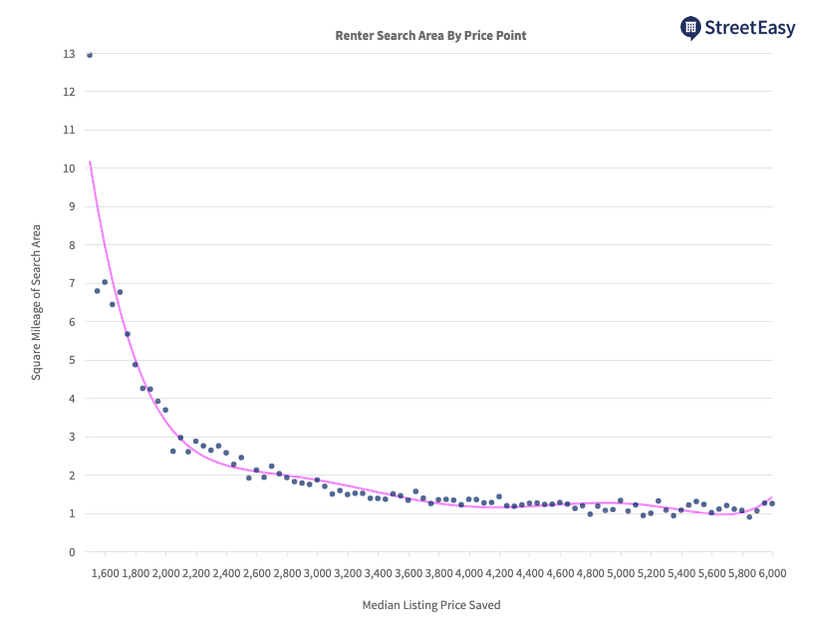
Renters on tighter budgets are often forced to trade location for a unit that fits their price, while those seeking higher-priced units tend not to stray from their desired area. Renters looking around the $4,000 price point saved listings across 1.4 square miles, an area roughly the size of Central Park. For those searching at around $2,000, the average search area more than double that: 3.7 square miles. And at $1,800 per month, the average search area widens to 4.9 square miles.
For many renters, then, a higher price point means the ability to pick a neighborhood and find something that meets their needs with it. Those searching at lower price points often do not have this flexibility, and tend to expand their search to other neighborhoods.
Many shoppers looking further from the city center are discovering attractive neighborhoods they hadn’t previously considered, though over the long run, this trend has driven up rents in many of these areas faster than in the city overall.
3. Renters seeking lower-priced units have to search much further from the city center.
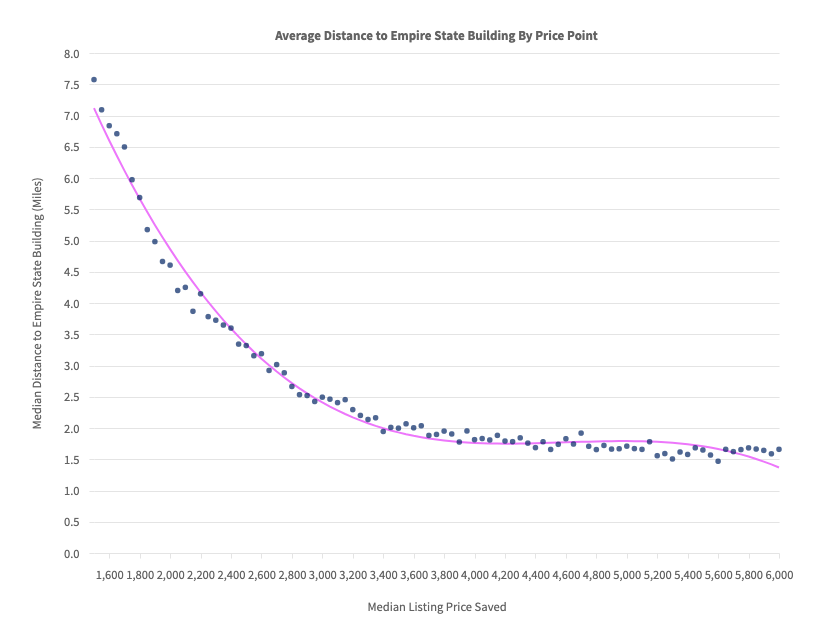
While outlying neighborhoods in parts of Upper Manhattan, Queens, and Brooklyn have seen a steady increase in interest among renters, our analysis suggests that much of this interest is driven by budgetary concerns. While relatively more affordable units are spread across all five boroughs, the relationship between rents and the average distance to central points in Manhattan remains tight.
Renters searching for homes around $2,000 tended to look 4.2 miles away from the Empire State Building, while those searching for homes around $4,000 tended to search, on average, less than two miles from the Empire State Building. Other major landmarks — including Wall Street, Times Square and Union Square — show similar average trends.
Like the practice of widening search areas, this trend also highlights the willingness of New Yorkers on a budget to search beyond their preferred neighborhood, and suggests that others might like what they find when they get there.
4. Budget-conscious renters stray farther from their first saved listing than those on higher budgets.
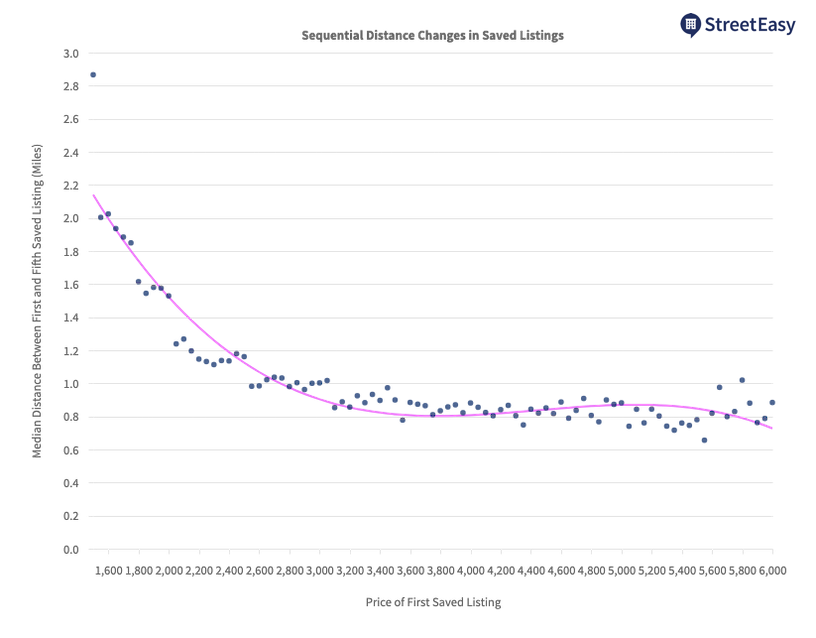
Not only do renters on a budget tend to look farther from the city center, they also tend to look farther from their first saved units as their search progresses. For those first saving homes renting around $2,000, their fifth save was, on average, 1.2 miles away from their first save — roughly the distance between Fort Greene Park and Prospect Park.
Those on higher budgets tend to save roughly the same number of apartments as those on tighter budgets, but they tend to remain closer to the first unit they save as their search progresses. For those initially saving a unit renting for $4,000, their fifth save was just 0.8 miles away. This suggests that those with higher budgets are more likely to be able to afford their first choice in neighborhood, whereas those on tighter budgets are likely to sacrifice their preferred location for financial considerations.
5. Renters seeking cheaper rentals tend to look at more expensive homes as they search.
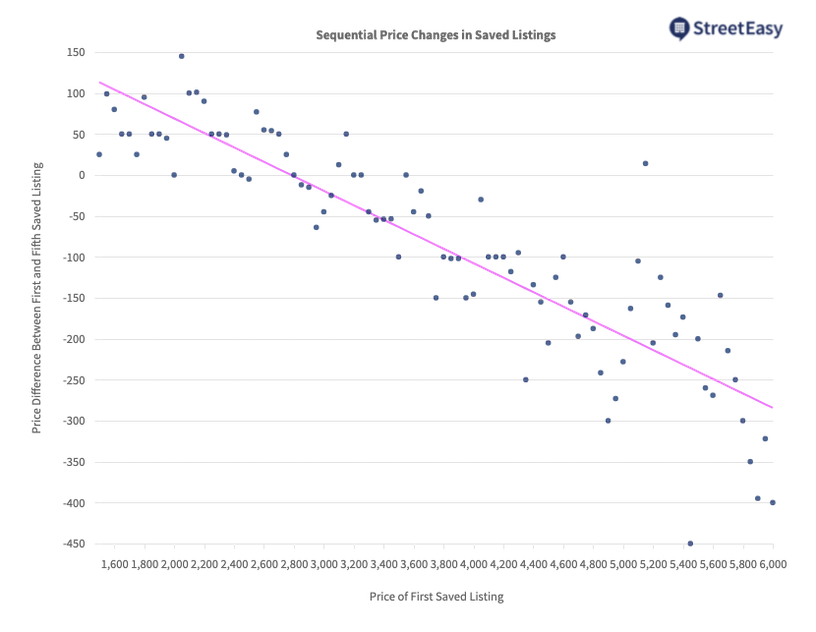
Budget creep — the tendency among renters to look at more expensive homes as their search progresses — is real, but only among those searching at the lower end of the price spectrum. On average, those who initially save units renting for around $2,000 will increase their budget by about $70 by the fifth unit they consider.
However, the tendency for budgets to grow as users save more units arises mainly in searches up to $2,700 — at which point renters tend to decrease the price of homes they save as their search progresses. Those who initially save a unit for $4,000 will save a fifth unit that is on average $107 less expensive than the initial unit. For many with larger budgets, the benefits of paying up for a home with extra amenities or a slightly larger layout appears not to be worth it.
Though some elements of budget creep may be inevitable due to the high prices in the city, it’s a trend that home searchers should keep in mind. Constructing a realistic budget with some room for adjustment is crucial to finding an affordable home in a timely manner, and those without much financial flexibility may want to consider other ways to save, including searching for a roommate.
Trade-offs Are Tied to Broader Economic Trends
It is hardly surprising that renters make trade-offs and that those trade-offs are dependent on budget. However, what is striking is just how predictable the patterns of NYC apartment searchers are. The fact that so many geographic facets of the home search are so closely tied to budget suggests that many of the trends witnessed in the real market are driven by budgets — not other preferences.
In other words, the coffee shops, trendy retail storefronts, and organic grocery stores popping in neighborhoods where such things would have been unthinkable 20 years ago are a direct result of the rising share of New Yorkers forced to look beyond more central parts of the city, and are not themselves the forces increasing demand for homes in these areas.
These and many of the other changes the city is going through are tied to the city’s economic resurgence since the last recession, which has increased the tax base and total number of jobs in the city. However, these changes also drive more and more New Yorkers to make difficult choices when looking for a home.
How We Did It
StreetEasy crunched data on millions of instances in which users saved listings during 2018. We excluded users saving listings in fewer than three buildings or more than fifty buildings, in addition to users identified as real estate agents or other real estate professionals. The resulting analysis aggregates StreetEasy behavior across hundreds of thousands of users, highlighting how average behavior changes across price points.
[1] According to U.S. Census data from 2017.
--
Inspired to find your next place in New York? Whether you're looking to rent or to buy, search NYC apartments on StreetEasy.









